Implementing flatpack container houses comes with various risks and challenges that need to be carefully considered and mitigated to ensure the success of the project. Here are some potential risks and challenges associated with flatpack container houses:
Construction and Installation
Quality Control Issues: Ensuring that all components of the flatpack containers meet required standards before assembly.
Assembly Complexity: Challenges in correctly assembling modules on-site, especially in remote or challenging environments.
Transportation Logistics: Difficulty in transporting large modular units to remote or inaccessible locations, requiring specialized equipment and planning.
Foundation Requirements: Ensuring the site is adequately prepared with suitable foundations to support the weight and structure of the container modules.
Structural Integrity
Corrosion and Rust: Despite being made from corten steel, containers can still be susceptible to rust and corrosion, especially in coastal or humid environments.

Sealing and Insulation: Ensuring proper sealing and insulation to prevent air leaks, moisture ingress, and maintaining thermal efficiency.
Wind and Seismic Loads: Designing containers to withstand high wind speeds and seismic activity in earthquake-prone regions.
Regulatory and Compliance
Building Permits and Zoning Regulations: Ensuring compliance with local building codes, zoning regulations, and permits, which can vary widely between jurisdictions.
Environmental Impact: Addressing concerns related to the environmental impact of construction, especially in sensitive ecosystems or protected areas.
Operational Considerations
Utilities and Services: Ensuring adequate provision of water, electricity, sewage, and waste management services to the container units.
Maintenance and Durability: Implementing a maintenance plan to address wear and tear over time, including repainting, sealing, and structural maintenance.
Insurability: Ensuring that container houses are insurable and covered against risks such as fire, theft, and natural disasters.
Cost and Budget
Initial Cost vs. Long-Term Savings: Balancing the upfront costs of purchasing and assembling container units with potential long-term savings in construction and operational expenses.
Budget Overruns: Potential for unexpected costs during transportation, assembly, site preparation, and modifications.
Community and Stakeholder Engagement
Public Perception: Addressing potential stigma or negative perceptions associated with container housing in communities.
Stakeholder Buy-In: Gaining support from stakeholders including local communities, government authorities, and project investors.
Adaptability and Future Use
Flexibility in Design: Ensuring that container units can be easily modified or expanded to meet changing needs or future expansion.
Resale Value: Considering potential limitations on the resale market for container houses compared to traditional construction.
Successfully implementing flatpack container houses requires thorough planning, careful consideration of risks, and proactive mitigation strategies. By addressing these challenges early in the planning stages and throughout the project lifecycle, stakeholders can
minimize risks and maximize the benefits of container housing solutions, including cost-efficiency, sustainability, and rapid deployment capabilities.








